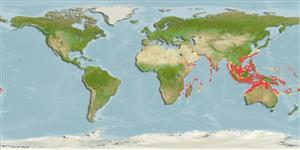Actinopterygii (ray-finned fishes) >
Perciformes (Perch-likes) >
Caesionidae (Fusiliers) > Gymnocaesioninae
Etymology: Gymnocaesio: Greek, gymnos = naked + Latin, caesius, bluish-grey, 1835; it is the same name given to the silvery metal (Cs) (Ref. 45335).
Environment / Climate / Range
Ecology
Marine; reef-associated; non-migratory; depth range 0 - 500 m (Ref. 402). Tropical, preferred ?; 31°N - 30°S, 32°E - 177°W (Ref. 402)
Indo-West Pacific: Red Sea and East Africa to Fiji, north to the Philippines.
Size / Weight / Age
Maturity: Lm ? range ? - ? cm
Max length : 18.0 cm TL male/unsexed; (Ref. 402)
Inhabits coastal areas around coral reefs (Ref. 30573). Feeds on zooplankton in large midwater aggregations. Forms schools with members of the genus Pterocaesio. Oviparous, with numerous, small pelagic eggs (Ref. 402). Often mistaken for juveniles and easily overlooked because of small size (Ref. 48636). Also caught with drive-in nets. Utilized as tuna bait fish (Ref. 30573).
Life cycle and mating behavior
Maturity | Reproduction | Spawning | Eggs | Fecundity | Larvae
Carpenter, K.E., 1987. Revision of the Indo-Pacific fish family Caesionidae (Lutjanoidea), with descriptions of five new species. Indo-Pac. Fish. (15):56 p. (Ref. 1723)
IUCN Red List Status (Ref. 115185)
CITES (Ref. 94142)
Not Evaluated
Threat to humans
Harmless
Human uses
Fisheries: minor commercial; bait: usually
More information
ReferencesAquacultureAquaculture profileStrainsGeneticsAllele frequenciesHeritabilityDiseasesProcessingMass conversion
Tools
Special reports
Download XML
Internet sources
